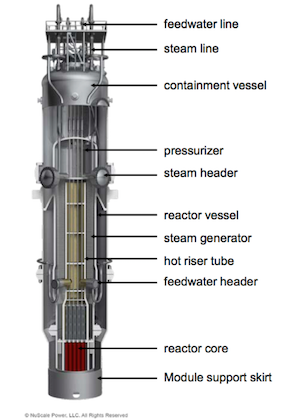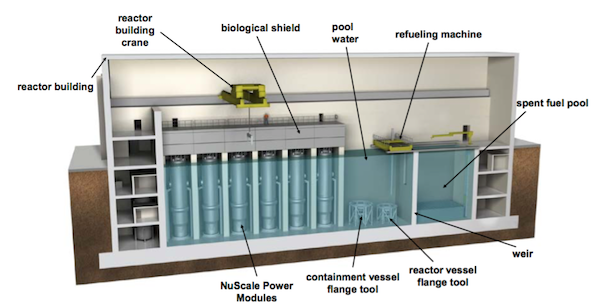This article was published in Scientific American’s former blog network and reflects the views of the author, not necessarily those of Scientific American

A small modular nuclear reactor (SMR) is an integrated unit that harnesses heat from a nuclear reaction to make steam. Source: Ingersoll et al., 2015.
Last week, the Tennessee Valley Authority (TVA) submitted the first-ever permit application to the U.S. Nuclear Regulatory Commission (NRC) for a small modular nuclear reactor. The TVA’s application comes as a huge milestone in the pathway of small modular reactors (often abbreviated SMRs) from the laboratory to the marketplace, and brings a glimmer of hope to the future of nuclear power in the United States.
“This submittal is a key milestone for our company and the nuclear industry,” said TVA Chief Nuclear Officer Joe Grimes. “TVA is the first in the industry to submit any type of application related to SMRs to the NRC. It’s a significant event for us as we continue exploring potential SMR technology as a way of expanding our diverse portfolio to ensure a safe, reliable supply of energy for those we serve.”
On supporting science journalism
If you're enjoying this article, consider supporting our award-winning journalism by subscribing. By purchasing a subscription you are helping to ensure the future of impactful stories about the discoveries and ideas shaping our world today.
The NRC will use the application to review site safety, environmental and emergency preparedness requirements for potential construction of the next-generation nuclear technology at the 1,200-acre Clinch River site near Oak Ridge, Tennessee.
Let’s review what advantages SMRs have over conventional nuclear reactor designs, and why they have the potential to overcome some of the key barriers limiting new nuclear construction today.
Small Matters
One of the main issues associated with siting and financing a nuclear plant is economics. In the past, vertically integrated monopoly utilities could make 50-year investments in large-scale nuclear plants with the knowledge that their ratepayers to which they had exclusive access would foot the bill.
With today’s competitive electricity markets, generators must compete to provide power exactly where and when it is needed at the lowest price. This fact makes it harder to predict what price a nuclear power plant will be paid for its electricity, and thereby makes it more difficult to justify a long-term investment in nuclear versus something like natural gas or renewable energy. It’s not a coincidence that the only new nuclear generating units under construction in the United States are owned by Southern Company, a regulated utility.
The investment outlook for nuclear is made worse by the fact that conventional nuclear power plants must be built at a huge scale to justify their upfront cost. This means than any new conventional nuclear plant will bring a lot of new electricity to the power market, shifting the supply curve and depressing the market electricity price. It’s simple economics: if there’s too much supply in the market versus demand, the price goes down. Similar forces have depressed global oil prices as Saudi Arabia holds production steady to compete with U.S. oil producers.
SMRs don’t have the same scale issue that conventional nuclear plants do. Because they are smaller, they require less upfront investment (even if the cost per unit of energy produced is higher). Furthermore, they are less likely to produce a supply glut in the marketplace. These features combine to make SMRs a lot more appealing than conventional nuclear from a finance perspective.
Modular Means Mass Production
The M in SMR stands for modular, which means that the reactors are designed to operate as independent units but can interconnect to form a large-scale power plant if necessary. A benefit of this design is that reactors have the potential to be manufactured on a modern production line rather than as custom-built capital projects like conventional nuclear plants.

Several small nuclear modules can be interconnected to form a larger-scale nuclear power plant. Source: Ingersoll et al., 2015.
The mass-production potential of SMRs means they have the potential to reach economies of scale and achieve a much lower price point than today’s reactors. Think of a conventional reactor like a Rolls Royce automobile. Each unit is custom built and designed to the purchaser’s requirements. Whereas an SMR is more like a Toyota: every unit is the same but they achieve a better price point without sacrificing safety or reliability.
While existing U.S. reactors don’t have a standard design, the country of France already fully standardizes the design of all of its nuclear power plants. The standardization allowed France to become a world leader in nuclear power (75% of the country’s electricity comes from nuclear) and achieve one of the lowest electricity prices in Europe of 17 cents per kilowatt-hour when converted with purchasing power parities to U.S. dollars. Compare that to neighboring Germany’s 37 cents per kilowatt-hour or Poland’s 34 cents per kilowatt-hour. (All data from the International Energy Agency).
Flexible Enough to Be Friends with Renewables
Another factor that limits conventional nuclear power plants is that they were largely designed to operate as base load, i.e. produce electricity at their full output nearly 24 hours a day for every day of the year. In today’s dynamically priced electricity markets, it turns out this function is not actually very useful. The most valuable power plants can produce electricity at a low cost and quickly turn on an off in order to capture high electricity prices and avoid periods where the real-time price of electricity is low — especially periods where overproduction of renewable energy versus demand causes the price to become negative.
A recent technical paper by researchers from NuScale, one of the leading SMR technology companies, titled “Can Nuclear Power and Renewables Be Friends?” shows the potential for NuScale’s SMR to ramp up and down to balance electricity supply with demand — even when renewables make up a significant portion of total generation. Their system can effectively adjust its power output over long, medium, and short timescales. One or more of the system’s modules can be taken offline to reduce power output for days or months at a time. The thermal output of the reactor can be modulated to adjust power output from one hour to the next. And steam can be diverted from the turbine to the condenser to adjust power output on the timescale of minutes. All of these features give NuScale’s system a decisive economic advantage over conventional nuclear — and will help to integrate renewable energy with the grid into the future.
What’s Next
TVA’s move to build an SMR plant will provide valuable experience related to the siting, permitting, and operation of a next generation small-scale nuclear power facility. While it will be a long time before the proposed SMR facility is built and operational, it will no doubt help to the pave the way for the future of nuclear power in the United States. It will certainly be interesting to see where things go from here.
Agenda image credit: Ingersoll et al., 2015.